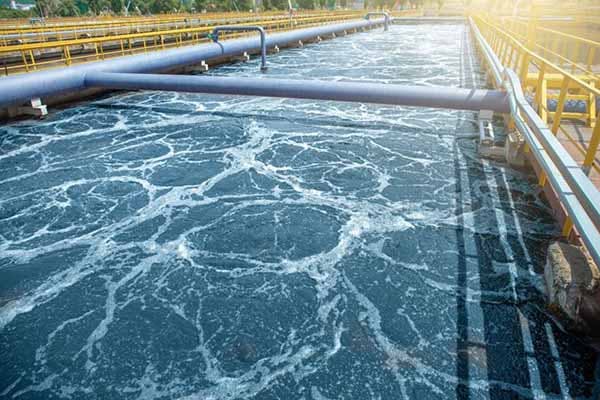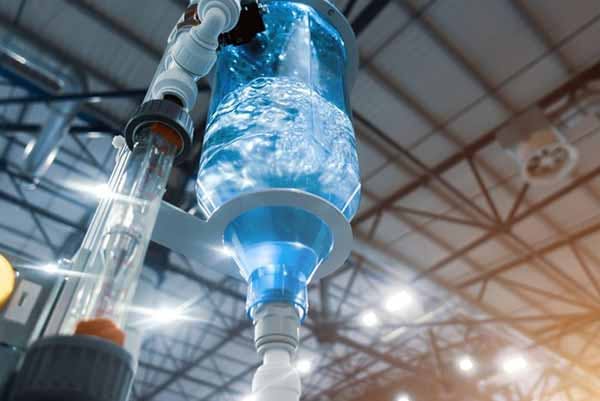July 2022
What Is Water Reclamation? Reuse, Recycle, Repurpose H2O
You may be wondering: What is water reclamation? Water reuse, or reclamation, is the practice of recycling used water and repurposing it for other uses.
There’s currently a drought in the western United States, so water reclamation, also called water reuse, is becoming increasingly important. In addition, with the Colorado River at historically low levels, there are legitimate concerns about the arid Southwest's water supplies.
The outlook on climate change is that weather patterns are changing and we can expect more of the same for the foreseeable future. Unfortunately, climate change isn't limited to the Southwestern states — it’s a national and global concern.
So, what can we do about our dwindling water supply? The answer may be reclaimed water.
This article will discuss what reclaimed or recycled water is, how the process is done, and how we can use it to relieve pressure on our demand for water, water supplies, and water systems.
What Is Water Reclamation?
You've likely heard the terms reclaimed water and recycled water, but what is water reclamation and what is the difference between the two alternate terms associated with it? Simply put, reclaimed water is water that's been used, treated, and made available for reuse. Once reclaimed water has been reused, it's called recycled water.
Water reclamation can reduce pressure on aquifers because instead of drawing water from an aquifer, we use reclaimed water instead. Water reuse also has environmental benefits because it decreases water diversion from sensitive ecosystems, such as wetlands and riparian habitats. Using reclaimed water also reduces or prevents pollution of such ecosystems and offers greater environmental protections.
What Are Aquifers?
An aquifer holds water in a sedimentary (rock) layer. When precipitation falls, it becomes groundwater that seeps into the soil and collects in a rocky or sedimentary formation's air spaces (pores). Once there, it becomes part of an aquifer; this is known as groundwater recharging.
Aquifers can be confined or unconfined. A confined aquifer has an impenetrable cap of rock or clay, while an unconfined aquifer has a porous layer above it. Fractured limestone, sandstone, clay, conglomerate, and gravel are different kinds of aquifers.
It's important to understand that aquifers aren’t underground lakes or rivers. The water in an aquifer doesn't flow like a river; it seeps. Likewise, it doesn't accumulate in the same way a lake does.
Wells are artificial discharge points for an aquifer. Natural discharge points are springs or wetlands. An overwhelming majority of our water supply comes from aquifers.
Changing precipitation patterns and user demand are causing us to deplete many aquifers because we use the water faster than the aquifer can recharge. Unfortunately, water management and water conservation are insufficient to mitigate the pressure on aquifers, but water reclamation can help.
What Are Examples of Reclaimed Water?
Once available for reuse, reclaimed water is available for agriculture, industry, and municipal water supplies.
There are three broad categories of water reclamation: potable, non-potable, and indirect potable reuse.
Wastewater irrigation generally means non-potable water reclamation. In most cases of non-potable water reuse for irrigation purposes, growers are irrigating non-food crops such as hay or cotton. In addition, many parks and golf courses use non-potable water for landscape irrigation.
Thermal power plants may also use non-potable reclaimed water for cooling purposes. However, even in this water reuse application, the reclaimed water needs to pass through a filtration system to remove contaminants, microorganisms, and corrosive elements that can damage or foul the surfaces of a plant's heat exchangers.
Indirect potable water has been treated and introduced through an environmental buffer. For example, stormwater and wastewater are initially treated at a wastewater treatment plant before introduction into lakes, rivers, or aquifers that act as ecological buffers. Once there, it becomes a source of drinking water. After further disinfection and treatment at a drinking water facility, the reclaimed water is introduced into the municipal water distribution system.
Direct potable water reuse, also called direct potable reuse (DPR), skips the intermediate step of an environmental buffer. Instead, wastewater goes directly to a municipal wastewater treatment plant and, possibly, to an advanced wastewater treatment plant for further processing.
Water treatment plants may also process the reclaimed water before it enters the municipal water supply.
What Is a Water Reclamation Project?
What is water reclamation as a project? A water reclamation project is the systematic collection and treatment of wastewater for reuse. Such reuse projects can produce either potable or non-potable end uses.
Water reclamation projects collect wastewater from residential, commercial, and industrial water consumers. In addition, stormwater is also collected for treatment at some water reclamation facilities (WRF).
Collection systems include two general sewer systems. Combined sewers collect human wastewater and stormwater, transporting them to a treatment facility. However, combined sewers can overflow during wet weather because of the rapid and large influx of stormwater. These are older systems; regulators haven't permitted combined sewers since the mid-20th century.
On the other hand, sanitary sewers are for wastewater collection only. Although they're usually built to allow higher flows during wet weather, sanitary sewers don't provide the same widespread drainage that a combined sewer does.
How Do Reclaimed Water Systems Work?
In sewage and industrial wastewater, known as effluent, wastewater enters sewers and other collection systems for routing to water treatment plants to begin the treatment process. Once there, pretreatment starts by removing biosolids through physical procedures. In addition to screening and raking, aeration basins and settling ponds encourage fine grit and particles to precipitate out of the water.
Secondary treatment mixes in oxygen to encourage bacterial microorganisms to consume the remaining organic material in the water. Non-settleable solids convert to settleable solids that are captured in final clarifiers. To remove any remaining solids, the process is returned to aeration basins for additional oxygenation.
After leaving the final clarifiers, the water moves onto advanced treatment. In this stage, the water goes through sand filtration to remove the remaining particles before continuing to the disinfection stage. During disinfection, the water treatment facility chlorinates the water to remove pathogens.
On completion of treatment, the water moves into the environment, usually rivers, lakes, or reservoirs. The point of entry into the environment is called the outflow.
At each stage of treatment, the water becomes safer for humans. Of course, the end use depends on the regulations governing the site. Still, generally water that's been through advanced treatment is safe for reentry into the environment and for aquifer recharging.
Why Are There Water Reclamation Projects in Colorado?
Despite images of Colorado's forested mountains, snow, and rippling rivers and streams, the truth is that Colorado is an arid region with 300 days of sunshine. What's more, the state's population of 5.4 million people is projected to double by 2050.
Further, in many areas of Colorado, soils are high in naturally occurring salts. Colorado faces a real water shortage with the effects of climate change, explosive population growth, and a growing economy.
Complicating this problem is that some 85% of the population lives in the state's eastern (and drier) part. Currently, Colorado diverts water from the state's western half to the population centers on the Front Range.
The Colorado Water Plan includes direct potable reuse (DPR). DPR treats and reuses wastewater without an environmental buffer. As a strategy for addressing Colorado's projected water supply shortage, it has significant potential to provide water for Coloradans.
How Many Water Reclamation Projects Are There in Colorado?
Colorado has over a dozen water recycling projects. Denver Water is the largest water reclamation facility in the state.
FAQs About Recycling Water
Before treatment, wastewater can include greywater, stormwater, surface water runoff, and sewage. Greywater is wastewater that hasn't been contaminated with human effluent (urine and fecal matter), foods, or greases.
Greywater sources include bathroom sinks, bathtubs and showers, and washing machines. Greywater is untreated, and therefore, non-potable. However, greywater may contain residues from soaps and other household products.
Wastewater treated at a water reclamation facility is reclaimed water, as we outlined above. Reclaimed water can be either potable or non-potable.
How Can We Reuse Wastewater at Home?
The wastewater used at home is greywater or captured rainwater from roofs and gutters. Reusing captured rainwater is as simple as installing rain barrels on your gutter's downspouts, screening out plant debris, and delivering the water to garden plants. More complex rooftop cistern systems are also available commercially.
Be sure to check with your state and local public health agencies for ordinances about rainwater reuse. For more information about rainwater reuse, you can visit the Environmental Protection Agency (EPA) website Green Infrastructure.
With greywater, it's essential to regularly monitor nutrient and salt levels to avoid the build-up of contaminants or pathogens. Also, be sure to check with local authorities about any requirements for greywater use.
Ways to use greywater at home include irrigating your landscaping, lawns, and ornamental shrubs. Other uses are washing your car, outdoor cleaning, and toilet flushing. You can also use leftover vegetable or pasta water to irrigate indoor plants.
How Do Municipalities Turn Sewage Into Drinking Water?
With tertiary treatment, treated wastewater undergoes reverse osmosis to remove bacteria, viruses, and chemicals (such as nitrogen and phosphorus), as well as pharmaceuticals. Additional treatment with UV light and hydrogen peroxide catches any contaminants that remain. The result is water quality that meets public health and drinking-water standards.
Water Reclamation Is Good Practice
Outdated water management practices, climate change, and a rapidly growing population are stressing our water supplies. Considering that water is one of our most valuable natural resources, it and its uses should concern us all.
Unfortunately, water conservation isn't enough to counteract the growing demand for fresh water to irrigate crops, parks, and golf courses. It also isn't enough to meet our industrial and commercial needs.
There’s considerable public resistance to converting wastewater to potable uses. But water treatment technology has advanced significantly in the last few decades. Consumer education and outreach can help win public acceptance of a toilet-to-tap water supply.
The sustainability of our water supplies depends on retooling our water treatment technologies to supply our water demands. From industry's process water to a glass of drinking water, water reclamation can be an essential tool in ensuring everyone has the water they need.
Brought to you by homewater.com
All images licensed from Adobe Stock.
Featured Image

